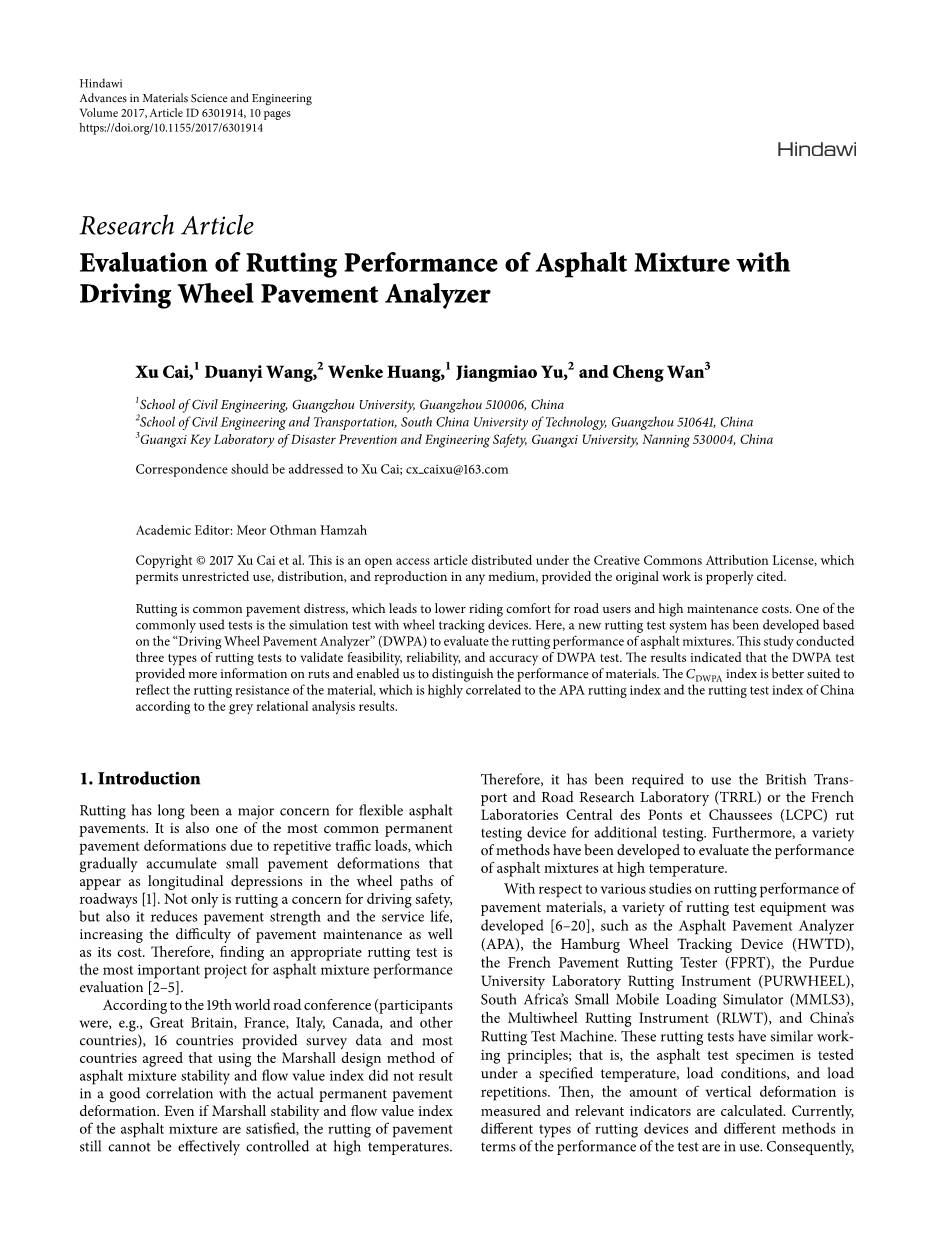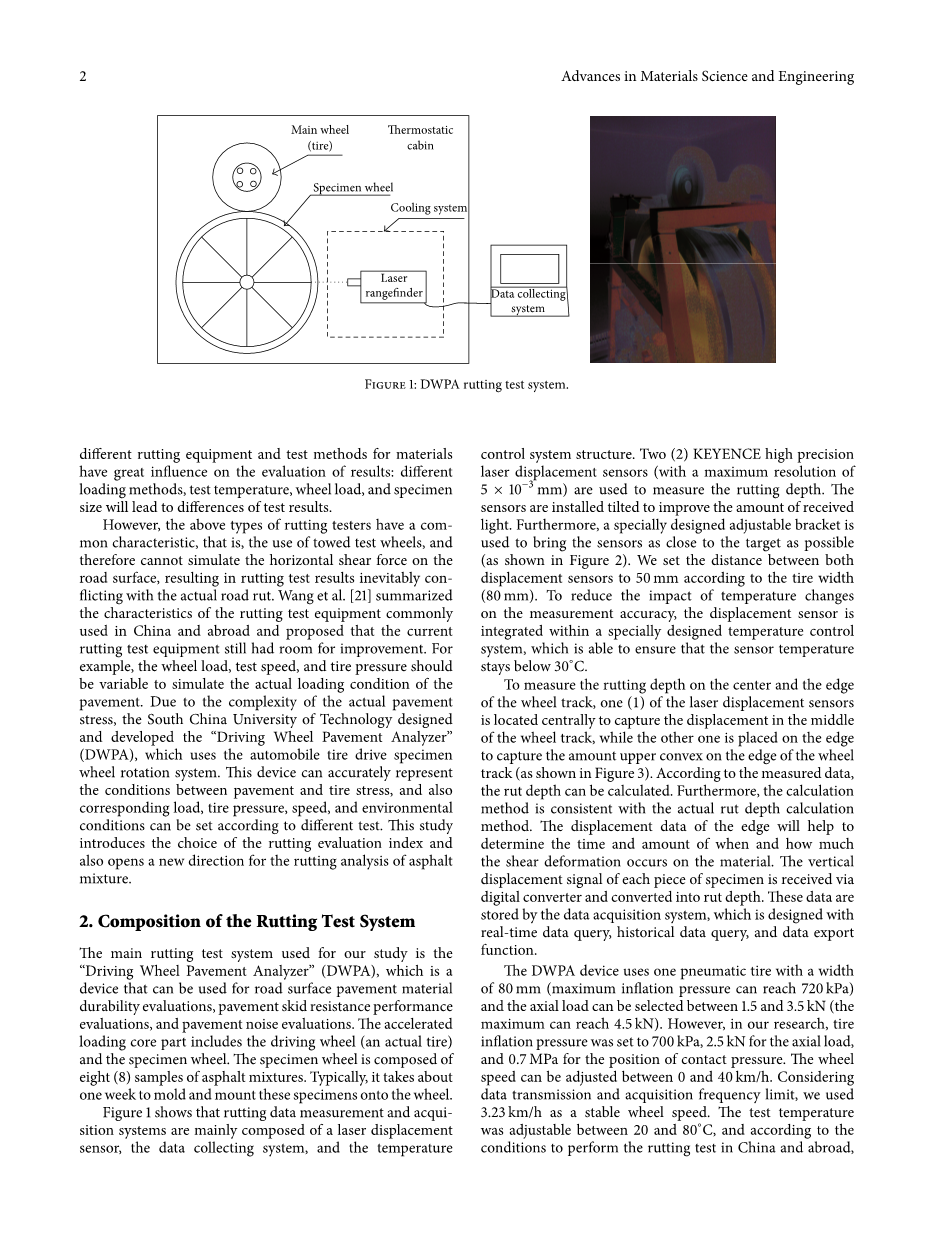

英语原文共 11 页,剩余内容已隐藏,支付完成后下载完整资料
Evaluation of Rutting Performance of Asphalt Mixture with Driving Wheel Pavement Analyzer
Rutting is common pavement distress, which leads to lower riding comfort for road users and high maintenance costs. One of the commonly used tests is the simulation test with wheel tracking devices. Here, a new rutting test system has been developed based on the “Driving Wheel Pavement Analyzer” (DWPA) to evaluate the rutting performance of asphalt mixtures. This study conducted three types of rutting tests to validate feasibility, reliability, and accuracy of DWPA test. The results indicated that the DWPA test provided more information on ruts and enabled us to distinguish the performance of materials. The ?DWPA index is better suited to reflect the rutting resistance of the material, which is highly correlated to the APA rutting index and the rutting test index of China according to the grey relational analysis results.
1. Introduction
Rutting has long been a major concern for flexible asphalt pavements. It is also one of the most common permanent pavement deformations due to repetitive traffic loads, which gradually accumulate small pavement deformations that appear as longitudinal depressions in the wheel paths of roadways [1]. Not only is rutting a concern for driving safety, but also it reduces pavement strength and the service life, increasing the difficulty of pavement maintenance as well as its cost. Therefore, finding an appropriate rutting test is the most important project for asphalt mixture performance evaluation
According to the 19th world roadconference (participants were, e.g., Great Britain, France, Italy, Canada, and other countries), 16 countries provided survey data and most countries agreed that using the Marshall design method of asphalt mixture stability and flow value index did not result in a good correlation with the actual permanent pavement deformation. Even if Marshall stability and flow value index of the asphalt mixture are satisfied, the rutting of pavement still cannot be effectively controlled at high temperatures. Therefore, it has been required to use the British Transport and Road Research Laboratory (TRRL) or the French Laboratories Central des Ponts et Chaussees (LCPC) rut testing device for additional testing. Furthermore, a variety of methods have been developed to evaluate the performance of asphalt mixtures at high temperature.
With respect to various studies on rutting performance of pavement materials, a variety of rutting test equipment was developed [6–20], such as the Asphalt Pavement Analyzer (APA), the Hamburg Wheel Tracking Device (HWTD), the French Pavement Rutting Tester (FPRT), the Purdue University Laboratory Rutting Instrument (PURWHEEL), South Africarsquo;s Small Mobile Loading Simulator (MMLS3), the Multi wheel Rutting Instrument (RLWT), and Chinarsquo;s Rutting Test Machine. These rutting tests have similar working principles; that is, the asphalt test specimen is tested under a specified temperature, load conditions, and load repetitions. Then, the amount of vertical deformation is measured and relevant indicators are calculated. Currently, different types of rutting devices and different methods in terms of the performance of the test are in use. Consequently, different rutting equipment and test methods for material shave great influence on the evaluation of results: different loading methods, test temperature, wheel load, and specimen size will lead to differences of test results.
However, the above types of rutting testers have a common characteristic, that is, the use of towed test wheels, and therefore cannot simulate the horizontal shear force on the road surface, resulting in rutting test results inevitably conflicting with the actual road rut. Wang et al. [21] summarized the characteristics of the rutting test equipment commonly used in China and abroad and proposed that the current rutting test equipment still had room for improvement. For example, the wheel load, test speed, and tire pressure should be variable to simulate the actual loading condition of the pavement. Due to the complexity of the actual pavement stress, the South China University of Technology designed and developed the “Driving Wheel Pavement Analyzer”(DWPA), which uses the automobile tire drive specimen wheel rotation system. This device can accurately represent the conditions between pavement and tire stress, and also corresponding load, tire pressure, speed, and environmental conditions can be set according to different test. This study introduces the choice of the rutting evaluation index and also opens a new direction for the rutting analysis of asphalt mixture.
2. Composition of the Rutting Test System
“Driving Wheel Pavement Analyzer” (DWPA), which is a device that can be used for road surface pavement material durability evaluations, pavement skid resistance performance evaluations, and pavement noise evaluations. The accelerated loading core part includes the driving wheel (an actual tire) and the specimen wheel. The specimen wheel is composed of eight (8) samples of asphalt mixtures. Typically, it takes about one week to mold and mount these specimens onto the wheel. Figure 1 shows that rutting data measurement and acquisition systems are mainly composed of a laser displacement sensor, the data collecting system, and the temperature control system structure. Two (2) KEYENCE high precision laser displacement sensors (with a maximum resolution of 5times;10minus;3mm) are used to measure the rutting depth. The sensors are installed tilted to improve the amount of received light. Furthermore, a specially designed adjustable bracket is used to bring the sensors as close to the target as possible (as shown in Figure 2). We set the distance between both displacement sensors to 50mm according to the tire width (80 mm). To reduce the impact of temperature changes on t
全文共33874字,剩余内容已隐藏,支付完成后下载完整资料
资料编号:[13119],资料为PDF文档或Word文档,PDF文档可免费转换为Word


